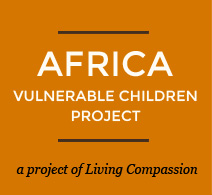Audio clip of thes Masala Primary school kids singing “How Could Anyone”. Click the play button below (or download the MP3 to your computer):
Saturday, July 23 10:20 PM
Bright and early Monday morning, our group gathered for a 6:30 a.m. departure for Livingstone and Victoria Falls. All 10 of us piled into the friary minibus for a 5 ½ hour drive with Brother John behind the wheel. Traveling through the countryside further exposed us to the people and landscape of Zambia. For the entire distance, we saw more people walking on the side of the road (often barefoot, with children on their backs and/or carrying large bundles on their heads) than we saw other cars.
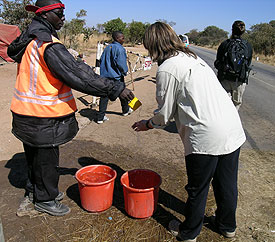 Among the small towns we passed through was Mazambuka, the birthplace of Brother John and Ignatius. We all commented that we liked the feel of that community, and they noted that it was a more prosperous area because of the sugar cane grown there. Another interesting moment on our journey was the hand-washing station that required us to get out of the bus and walk past while someone poured cold water on our hands to “disinfect” us from carrying hoof-and-mouth disease into that area.
Among the small towns we passed through was Mazambuka, the birthplace of Brother John and Ignatius. We all commented that we liked the feel of that community, and they noted that it was a more prosperous area because of the sugar cane grown there. Another interesting moment on our journey was the hand-washing station that required us to get out of the bus and walk past while someone poured cold water on our hands to “disinfect” us from carrying hoof-and-mouth disease into that area.
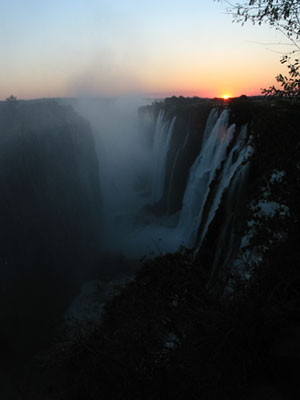 We arrived in Livingstone around 1:00 p.m. and, after checking into our lodge, went straight to Victoria Falls. It was striking that the falls were so easily accessible from the road—suddenly, there it is! The locals call it “Mosi Oa Tunya” which translates to the “Smoke that Thunders”—an apt name as the two overwhelming characteristics at the falls are its great roar and the pervasive mist that comes down like rain (click the play button below to hear a record we made at Victoria Falls or download the MP3 to your computer). Each turn we took on the path along the gorge which stretches between Zambia and Zimbabwe brought another awesome view: rainbows, double rainbows, baboons and vervet monkeys frolicking along the path and in the trees and bungee jumpers from the border bridge. We watched the sun set directly over the falls and it was so beautiful we decided to come back the next night for a sunset/full moonrise picnic.
We arrived in Livingstone around 1:00 p.m. and, after checking into our lodge, went straight to Victoria Falls. It was striking that the falls were so easily accessible from the road—suddenly, there it is! The locals call it “Mosi Oa Tunya” which translates to the “Smoke that Thunders”—an apt name as the two overwhelming characteristics at the falls are its great roar and the pervasive mist that comes down like rain (click the play button below to hear a record we made at Victoria Falls or download the MP3 to your computer). Each turn we took on the path along the gorge which stretches between Zambia and Zimbabwe brought another awesome view: rainbows, double rainbows, baboons and vervet monkeys frolicking along the path and in the trees and bungee jumpers from the border bridge. We watched the sun set directly over the falls and it was so beautiful we decided to come back the next night for a sunset/full moonrise picnic.
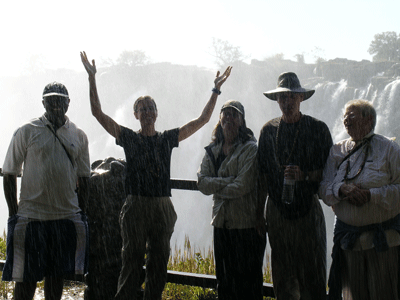
We hunted down a vegetarian dinner at an Indian restaurant and made our way back to the lodge where we spent the night in cute chalets with only screens for windows and mosquito-netted beds.
 There was a sharp morning chill the next day as we gathered for a 6:30 sit cramped in one of the chalets. Breakfast was corn flakes and tea as we huddled together for warmth. Our next destination was a game preserve in Livingstone where within two hours’ time we saw cape buffaloes, elephants, impalas, warthogs, giraffes, bushbucks, baboons, and zebras. The highlight was when our hired armed scout allowed us to get out of our vehicle for a closer viewing (less than 5 yards away) of the two endangered white rhinos at the park, which are guarded 24 hours a day against poachers.
There was a sharp morning chill the next day as we gathered for a 6:30 sit cramped in one of the chalets. Breakfast was corn flakes and tea as we huddled together for warmth. Our next destination was a game preserve in Livingstone where within two hours’ time we saw cape buffaloes, elephants, impalas, warthogs, giraffes, bushbucks, baboons, and zebras. The highlight was when our hired armed scout allowed us to get out of our vehicle for a closer viewing (less than 5 yards away) of the two endangered white rhinos at the park, which are guarded 24 hours a day against poachers.
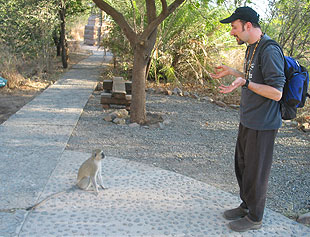
Lunch followed and then a trip back into town. The monks went to an Internet café while others in the group toured the Livingstone museum. Later, we were back at the falls and found a whole new trail that provided new and different views than we had seen before. We picknicked on the shore of the Zambezi, watching a fisherman cross the river as the water rushed towards the edge. Another incredible sunset was followed by a full moon and moon rainbows over the falls.
Wednesday was another early morning as we took off before sunrise for an all-day drive up to Ndola. We stopped for a break in Lusaka and packed into the minibus all the rest of our luggage, which seemed like a daunting task but we did it. Brother John and Ignatius laughingly told us we were having a true African experience of riding elbow to elbow in a vehicle packed full of people. On the way we watched a fantastic sunset and moonrise and then once again we were driving in the dark. By the time we got to Ndola, we were so happy to stretch our legs and have a lovely dinner at the friary with the brothers. It was a great pleasure to settle into our new rooms that would be our home base for the remainder of the trip.
